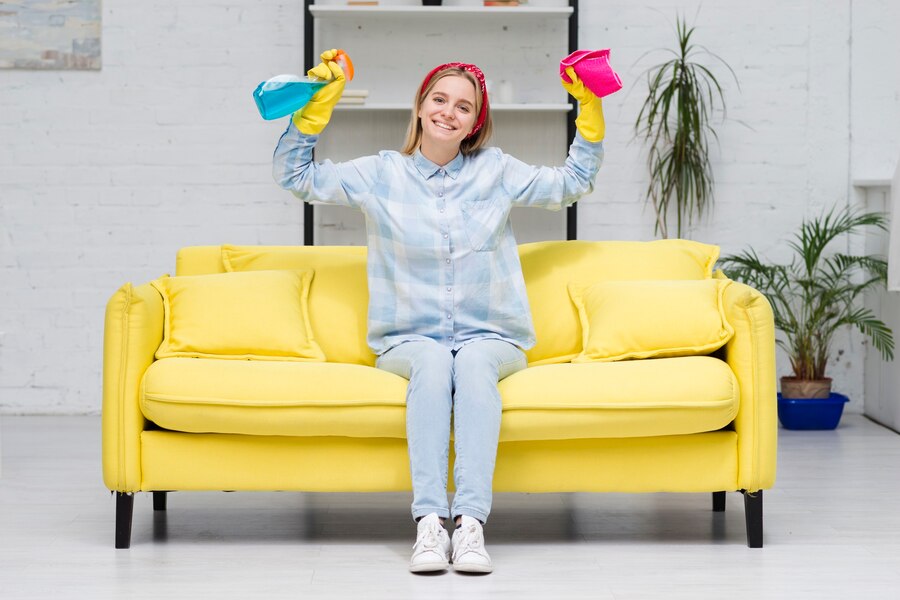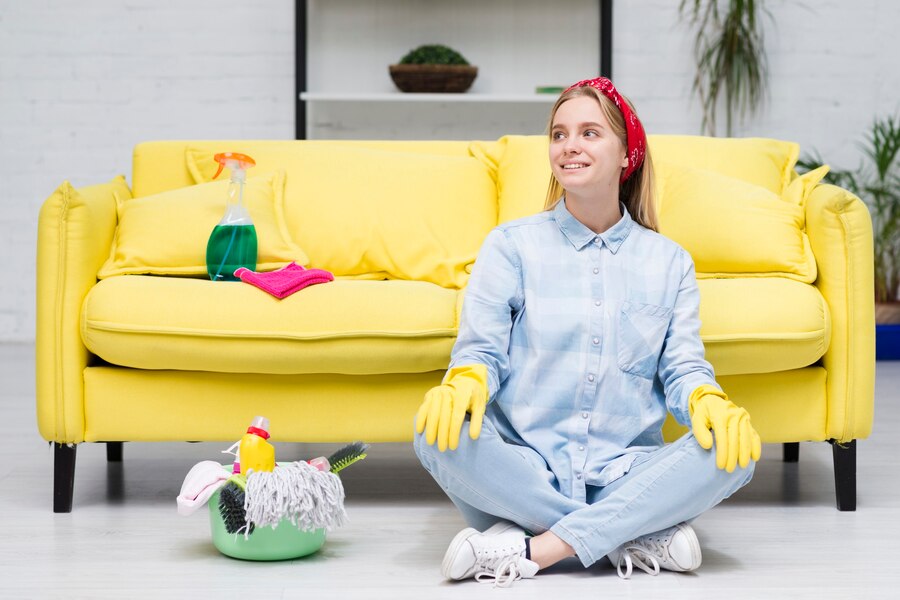Your couch serves as a central hub in your space—it’s where people wait, relax, and meetings take place. But beneath its surface lies a hidden threat: germs and bacteria that can compromise the health and safety of everyone who uses it.
But with the right strategies in place, you can ensure that your commercial space not only exudes professionalism but also fosters a healthy environment for employees and clients alike. So let’s explore how to elevate your commercial cleaning regimen and transform your couches into beacons of cleanliness and comfort.
Why is it Essential to Recognize the Need for Disinfection?
Think about all the people who sit on your couches each day. They bring with them all kinds of stuff—food crumbs, dirt, and germs. That’s why it’s crucial to disinfect your couches regularly.
It’s not just about making them look nice; it’s about keeping your space healthy and safe. By disinfecting your couches often, you can reduce the risk of spreading germs and make sure your place stays welcoming for everyone.
How Does Thorough Preparation Enhance the Efficacy of Disinfection Efforts?
Before you dive into disinfecting your couch, it’s important to gather the necessary supplies and prepare the area. Here’s what you’ll need:
- Disinfectant: Choose a disinfectant that’s safe for use on fabric surfaces. Options include alcohol-based sprays or wipes, hydrogen peroxide, or fabric-safe disinfectant sprays. Make sure to check the label for compatibility with your couch material.
- Cleaning Supplies: You’ll also need basic cleaning supplies such as a vacuum cleaner with an upholstery attachment, a microfiber cloth, and gloves to protect your hands.
- Manufacturer’s Instructions: Take a moment to review the manufacturer’s instructions for your couch. Some materials may have specific cleaning requirements or recommendations that you’ll need to follow.
Once you have everything you need, you’re ready to begin the disinfection process. By taking these preparatory steps, you’ll ensure that you have a smooth and effective cleaning experience.
What are the Pre-Cleaning Steps When it Comes to How to Sanitize a Couch?
Before you start to disinfect a fabric couch, it’s essential to undertake some pre-cleaning steps to ensure the best results. Follow these steps:
- Remove Loose Cushions and Pillows: Take off any removable cushions and pillows from the couch. This will make it easier to access all areas of the couch for cleaning.
- Vacuum Thoroughly: Use a vacuum cleaner with an upholstery attachment to remove surface dust, dirt, and debris from the couch. Pay special attention to crevices, seams, and corners where dirt tends to accumulate.
- Treat Stains: If you notice any visible stains on the couch, treat them before disinfecting. Follow the manufacturer’s recommendations for stain removal, using appropriate cleaning solutions or stain removers.
By completing these pre-cleaning steps, you’ll ensure that your couch is ready for disinfection and that you achieve the best possible results.
Choosing the Right Disinfectant
Selecting the appropriate disinfectant is crucial for effectively sanitizing your couch while also preserving its fabric. Here’s how to choose the right one:
- Consider Compatibility: Check the manufacturer’s instructions for your couch to ensure compatibility with the chosen disinfectant. Some materials may be sensitive to certain chemicals, so it’s essential to use a product that won’t cause damage.
- Types of Disinfectants: There are several types of disinfectants suitable for fabric couches, including:
- Alcohol-based sprays or wipes: Effective against a wide range of germs and bacteria.
- Hydrogen peroxide: A gentle yet powerful disinfectant that is safe for most fabrics.
- Fabric-safe disinfectant sprays: Specifically formulated for use on upholstery, these products are designed to sanitize without causing damage.
- Test First: Before applying the disinfectant to the entire couch, test it on a small, inconspicuous area to check for any adverse reactions. This will help ensure that the disinfectant is safe to use and won’t cause discoloration or damage to the fabric.
By choosing the right disinfectant and taking the necessary precautions, you can effectively sanitize your couch without compromising its appearance or integrity.
Disinfecting Process
Now that you’ve prepared your couch and selected the appropriate disinfectant, it’s time to begin the disinfection process. Follow these steps:
- Apply Disinfectant: Spray or apply the disinfectant evenly across the entire surface of the couch. Pay close attention to high-touch areas such as armrests, seat cushions, and backrests.
- Allow Dwell Time: Check the product label for the recommended dwell time—the amount of time the disinfectant needs to remain on the surface to effectively kill germs and bacteria. This may vary depending on the specific product you’re using.
- Wipe Down: After the dwell time has elapsed, use a clean, damp microfiber cloth to wipe down the entire surface of the couch. This will help remove any excess disinfectant residue and ensure thorough coverage.
- Steam Cleaning (Optional): For deeper cleaning and sanitization, consider using a steam cleaner with an upholstery attachment. Steam can effectively kill germs and bacteria while also lifting dirt and stains from the fabric.
Drying and Ventilation
After disinfecting your couch, it’s crucial to ensure proper drying and ventilation to prevent moisture buildup and potential mold growth. Here’s what to do:
- Air Dry: Allow the couch to air dry thoroughly before replacing any cushions or pillows. This may take several hours, depending on factors such as humidity and airflow in the room.
- Promote Air Circulation: Open windows or use fans to promote air circulation around the couch. This will help speed up the drying process and ensure that the fabric dries evenly.
- Check for Dampness: Once the couch appears dry, check for any remaining dampness by lightly pressing on the fabric. If you feel any moisture, continue to allow the couch to air dry until it feels completely dry to the touch.
- Monitor for Mold: Keep an eye on the couch in the days following disinfection to ensure that mold does not develop. If you notice any signs of mold growth, such as musty odors or visible mold patches, take steps to address it immediately.
By properly drying and ventilating your couch after disinfection, you can maintain a clean and healthy living environment while preserving the integrity of the fabric.
Post-Cleaning Tips
Once you’ve completed the disinfection process, there are a few additional steps you can take to keep your couch clean and fresh:
- Wash Removable Covers: If your couch has removable cushion covers or pillowcases, consider washing them according to the manufacturer’s instructions. This will help remove any lingering dirt or bacteria and keep your couch looking its best.
- Regular Maintenance: Establish a routine cleaning schedule for your couch to prevent the buildup of dirt and bacteria between deep cleanings. Regularly vacuuming and spot-cleaning spills can help maintain a clean and sanitary surface.
- Protective Measures: Consider using protective covers or throws to shield your couch from spills and stains, especially if you have pets or young children who visit your place of business. This can help extend the life of your couch and make cleaning easier.
- Professional Cleaning: Periodically, consider hiring a professional upholstery cleaner to deep clean your couch and remove any embedded dirt or stains. Professional cleaning can help rejuvenate your couch and prolong its lifespan.
By incorporating these post-cleaning tips into your routine, you can help keep your couch clean, fresh, and inviting for years to come.
Safety Precautions
When disinfecting your couch, it’s essential to prioritize safety to protect yourself and your furniture. Here are some key safety precautions to keep in mind:
- Wear Gloves: Always wear gloves when handling disinfectants to protect your hands from any potential irritation or chemical exposure.
- Work in a Well-Ventilated Area: Ensure that the room where you’re disinfecting your couch is well-ventilated to prevent the buildup of fumes from the disinfectant.
- Test in a Small Area: Before applying the disinfectant to the entire couch, test it on a small, inconspicuous area to check for any adverse reactions, such as discoloration or damage to the fabric.
- Avoid Harsh Chemicals: Avoid using harsh chemicals or bleach-based products on your couch, as these can damage the fabric and compromise its integrity.
- Follow Manufacturer’s Instructions: Always follow the manufacturer’s instructions for both the disinfectant and your couch to ensure safe and effective cleaning.
By taking these safety precautions, you can disinfect your couch effectively while minimizing any potential risks to yourself or your furniture.

How to Disinfect Fabric Couch
When disinfecting your fabric couch, consider using eco-friendly disinfectants for a safer and more sustainable approach. Natural options like vinegar and essential oils can effectively sanitize while minimizing harsh chemical exposure. Additionally, incorporating regular sunlight exposure can help naturally disinfect and freshen your couch, as UV rays have germ-killing properties. By adopting these eco-friendly practices, you can maintain a healthy environment without compromising your furniture’s longevity.
How To Disinfect Upholstery
To disinfect upholstery effectively, start by vacuuming the surface to remove dirt and debris. Then, apply a fabric-safe disinfectant following the manufacturer’s instructions. Allow the disinfectant to sit for the recommended dwell time to effectively kill germs and bacteria. Wipe down the upholstery with a clean, damp cloth to remove any residue. For additional sanitization, consider using a steam cleaner with an upholstery attachment. Allow the fabric to air dry thoroughly before use. Regular disinfection of upholstery helps maintain a clean and healthy environment in your space.
You can also read: How to Clean Floor Tile Grout without Scrubbing
Learn Everything About How to Disinfect Your Sofa And Transform Your Office
Congratulations! You’ve now learned everything you need to know about how to disinfect a fabric couch effectively. By following the steps outlined in this guide, you can ensure that your couch remains clean, fresh, and free from harmful germs and bacteria. Regular disinfection is crucial for maintaining a healthy working environment for you, your staff, and your clients, especially when it comes to upholstery.
By incorporating these cleaning techniques into your routine, you can ensure that your couch remains not only looks great but also promoting a safe and hygienic space in your office. We hope this comprehensive guide has empowered you to understand how to disinfect upholstery, ultimately contributing to a cleaner, healthier office for yourself, your staff and your clients.

